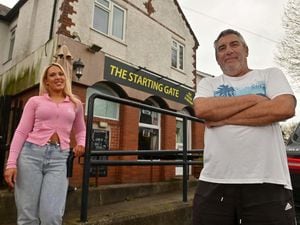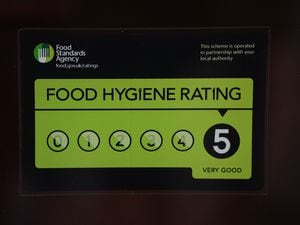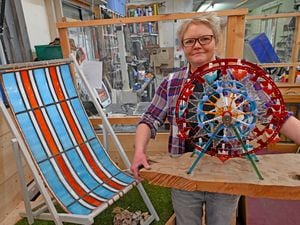Simple as ABC for 80s legend Martin Fry
He remains one of Britain’s ever-green stars. Martin Fry, the long-time frontman and driving force of ABC, has written his name into pop history, And as a new year dawns, he’s celebrating a bona fide pop classic, The Lexicon Of Love, which was released in 1982 and endures to this day.

ABC will tour the record in January and February on a tour that’s largely sold out, with three full houses at London Palladium, and similar, full-capacity shows at Birmingham Symphony Hall and in Liverpool, Manchester, Brighton, Sheffield, Gateshead, Truro, and elsewhere. A handful of tickets remain for the opening night, at Wolverhampton’s The Civic at the Halls, on January 25. The message is simple – with 15 shows on the tour already sold out, get them while you can.
ABC formed from the roots of Sheffield band, Vice Versa, just as new wave was making its mark on Britain’s post-punk scene. ABC’s first single, Tears Are Not Enough, made the UK top 20 in 1981.
In 1982, the band released their debut studio album The Lexicon of Love, which reached number one on the UK Albums Chart. Produced by Trevor Horn, it often features in UK critics’ lists of favourite albums: it ranked 42nd in The Observer Music Monthly’s Top 100 British Albums and 40th in Q magazine’s 100 Greatest British Albums.
The band had three top 10 hits during 1982: the singles Poison Arrow, The Look of Love, and All of My Heart. Several high-concept music videos were made, including the long-form spy pastiche Mantrap, by Julien Temple, who was then the UK’s hottest director.
Working with producer Horn was key to making The Lexicon Of Love. Martin says: “A combination of limited budget and Trevor’s low boredom threshold meant you’d got to come up with things pretty fast. He’d got a considerable pedigree; he’d had a number one record with Video Killed The Radio Star, with The Buggles. He’d made incredible records with Dollar and now he was producing ABC. I got the impression he liked us. I would often speak on behalf of the band and tell him that we were the absolute future of rock’n’roll.
“In the pizza parlour on our first meeting I had the job of telling him that everything apart from ABC was firmly stuck in the past and we were the future. My bandmate, Stephen Singleton, would be on my right-hand side, giving it the same. In retrospect Trevor saw straight through our self-aggrandisement. What I think he did admire was the energy and the chutzpah of it. I think that’s what captured his attention. He knew a lot about musicians, he’d sung with Yes, he’d become a star in The Buggles and was taking his studio producer role more seriously.
“I’ve met a lot of people before and after who would often talk and talk but only to tell you what they thought you wanted to hear. That’s not always useful when you’re making an album. Trevor understood the ABC mannerisms and reference points, from Kerouac to Bolan to Ken Dodd. A producer should always appreciate the nuances the artist brings. It was genuine, from our end. So we got in the studio and we started recording.”
Another key figure in the record was the brilliant composer, arranger, and pianist, Anne Dudley, with whom Martin continues to enjoy a long-standing musical friendship.
”Anne Dudley is a fantastic pianist. During the sessions she quickly evolved. Her work on strings was remarkable. At first Anne seemed quite serious, like a school mistress, but she’s really funny. We did a thing called Theme From Mantrap which was a jazzy, film noir piano version of Poison Arrow. It was all very spontaneous and quick to record. Anne’s the sort of person who can create something sensational in the studio in less than an hour.
“A lot of good stuff was happening during the evenings. I guess Trevor was just figuring out whether he liked working with us. He could pick and choose. So I guess the experience with Poison Arrow was important because it came out and it was a hit.”
The band were at the forefront of a new scene. Alongside such bands as Duran Duran, Dexy’s Midnight Runner, Culture Club, The Cure, Japan, and The Human League, they were redefining pop style. The landcape had changed. Punk was over. It was time for a new wave.
“And 1984 was just around the corner. Was it going to be everything George Orwell had predicted? In Sheffield, you’d just feel invisible. There was mass unemployment. What was the future? You had to make yourself heard. Otherwise we knew our generation was just going to get overlooked and ignored. That’s where that whole Peacock Culture of flamboyant New Romanticism came from.
Attitude
“Kids were dressing up to get noticed and to escape the humdrum world we’d inherited. People wanted to show off. The way girls dressed, boys dressed, that whole attitude. People sometimes think New Romantic is a term that covers it all. At the beginning of the 1980s it was truly aspirational. People had nothing and they had to create something by going to a jumble sale, by going to clubs, by creating a band and some music.
“That was before the 80s went all cocktail bar and yuppie. It wasn’t just about big shoulder pads and big choruses. When I think back, it was inevitable and had to happen. It came after punk. Punk was also about getting noticed, getting a reaction.”
ABC captured the nation’s imagination.
“In the 1980s, there was a new band offering a new world every week on the cover of Smash Hits or the NME and most of them were brilliant.
“Competition was fierce. I needed some stage clothes. We went to see a guy called Colin Wild. Colin claimed he had danced in Pan’s People and dressed Marc Bolan. I wanted a gold suit just like Elvis. Colin made that me a suit of armour in gold lame to wear on stage.”
And so began an iconic look. Martin was on his way to achieving his new gold dream. He’d been buying albums all his life and wanted to create something that people would still remember 40 years on, just like The Rise and Fall of Ziggy Stardust, or Closer by Joy Division. With ABC, with Trevor Horn, and with Anne Dudley, he seized the moment.
“I loved Tamla Motown. I loved Frank Sinatra and that whole song writing style of Rodgers and Hammerstein and Cole Porter. We wanted to mix that in with our modern view of the world. That’s why there was much more emphasis on emotions and love and romance. I loved the romanticism of Iggy Pop singing about the Endless Sea or Sinatra singing Ebb Tide.
“Romanticism is there when you want to look for it, in everybody’s music. Tears Are Not Enough is about climbing up off the canvas when a relationship has fallen apart. It’s about trying to pick up the pieces.
“I didn’t really think about it but the songs on the Lexicon Of Love were all written in a short space of time. I took a lifetime to develop and an afternoon to finish. People always ask if it’s about one person and it’s not. It’s just a combination of all those incidents that happen in your life and the stuff you hear about from other people, too. The core is about when somebody breaks your heart, how do you climb back up off the canvas.”
The album was a colossal hit, going platinum in the UK, gold in the USA, and reaching number one in places as far flung as New Zealand.
The album’s title originated in the headline of an NME review of an ABC gig. Songs were written collectively by the band, with arranger Anne Dudley also given a credit on some tracks. Martin had wanted to fuse the attitude of punk and the sophistication of disco. The Lexicon of Love featured recurrent themes, including heartache and the struggle to make meaningful connections. “Most of the other people were writing about electric pylons. We wanted to hark back to Cole Porter and his ilk, but in a very modern way.
“I remember sitting in a cafe in Sheffield one Saturday morning and the whole idea for The Look Of Love just crashing into my mind. I don’t know why, but it was just there. I always loved The Temptations and Sly And The Family Stone, where the vocalists would cut across each other.
“Prince did it on 1999. It’s a communal thing. That’s what I wanted to pull together on that song. ‘All I’m saying, it takes a lot to love you’. There’s a dialogue there. There’s call and response. The chorus just came to me, which was rare. It’s a really joyous, uplifting ecstatic song about love but also about how tough it is to get through the day, like the lyric: ‘When your world is full of strange arrangements , and gravity won’t pull you through’.”
ABC hit the road. They toured around the planet, from Wolverhampton to Tokyo.
“Going on tour was like joining the circus. We’d never toured like that before. We did 70 or 80 shows starting in Oxford augmenting the band with a six-piece string section and a three-piece horn section.
“The highlight was playing Hammersmith Odeon and David Bowie came down and stood in the wings, but unfortunately nobody told me because they knew I’d freak out. I think they made a conscious decision not to tell me, knowing I would have been distracted with Ziggy standing in the wings.
“The tour eventually climaxed in Tokyo and on the final date I was staying in the Keio Plaza hotel . I left my gold suit there. For years, people imagined I’d flushed it down the toilet at the end of a tour, which enhanced the ABC myth, but basically I was sick of wearing the gold suit and ready to reinvent myself. I’d been wearing that for the last two or three months, solidly, on stage. The real reason was shopping.
Souvenirs
“I needed space in my suitcase and I wanted to take home all the gadgets I’d bought in Japan. There was talk of a Walkman, a machine that you put a cassette into and then you could listen to music while you were on the move. There was robot shaped watches because Japan at the time was technologically advanced. So I was taking home all my souvenirs. Over the years, that story has grown in size. It’s like the red shoes. I used to tell people that the suit did the show for me. If I didn’t wear it, it would just show up and do the moves.”
During a brief period in New York, Martin was invited to meet the iconic artist, Andy Warhol. “It was the final days of Studio 54 and Pat Hackett his co-writer introduced us to him. We got this call to the hotel on the Tuesday morning asking if we’d like to go and meet Andy at the Factory.
“Andy was there and he was the most down-to-earth guy you could meet. He was talking about acne products because his skin wasn’t great and neither was mine. He was drinking a cup of coffee and people would constantly come in and ask him to sign paintings and prints.
“I wish I could have bought some art from him though I did get him to sign some 3D postcards I had. He was talking about videos and how impressed he was with Poison Arrow and The Look of Love. He said he liked them. He was very charming. He was very aware of the visual side of all of the British bands, like ABC, or Duran Duran, or Soft Cell. He was proud of Interview magazine. He liked hanging out with loads of different socialites and entertainers, that was his thing. Going to the Factory was like going down for an audition. We just went there and had a chat with him, hung out with him.”
And now it’s time to return to The Lexicon Of Love. Martin has happy memories of shows in Wolverhampton – and that’s where, on January 25th, his new tour starts.





